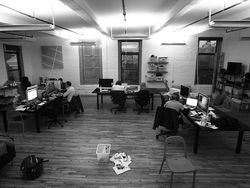Last week's MBA Mondays post on What A CEO Does was a huge hit. Matt Blumberg, who is one of the finest CEOs I've had the pleasure of working with, wrote a follow-up post on the topic for his blog. I asked him if I could run it as a guest post here on MBA Mondays and he agreed.
So, here's a bit more on What A CEO Does:
—-
What Does a CEO Do, Anyway?
Fred has a great post up last week in his MBA Mondays series caled “What a CEO Does.“ His three things are set vision/strategy and communicate broadly, recruit/hire/retain top talent, and make sure there’s enough cash in the bank.
It’s great advice. These three are core job responsibilities of any CEO, probably of any company, any size. I’d like to build on that premise by adding two other dimensions to the list.
First, three corollaries – one for each of the three responsibilities Fred outlines.
• Setting vision and strategy are key…but in order to do that, the CEO must remember the principle of NIHITO (Nothing Interesting Happens in the Office) and must spend time in-market. Get to know competitors well. Spend time with customers and channel partners. Actively work industry associations. Walk the floor at conferences. Understand what the substitute products are (not just direct competition).
• Recruiting and retaining top talent are pay-to-play…but you have to go well beyond the standards and basics here. You have to be personally involved in as much of the process as you can – it’s not about delegating it to HR. I find that fostering all-hands engagement is a CEO-led initiative. Regularly conduct random roundtables of 6-10 employees. Send your Board reports to ALL (redact what you must) and make your all-hands meetings Q&A instead of status updates. Hold a CEO Council every time you have a tough decision to make and want a cross-section of opinions.
• Making sure there’s enough cash in the bank keeps the lights on…but managing a handful of financial metrics in concert with each other is what really makes the engine hum. A lot of cash with a lot of debt is a poor position to be in. Looking at recognized revenue when you really need to focus on bookings is shortsighted. Managing operating losses as your burn/runway proxy when you have huge looming CapEx needs is a problem.
Second, three behaviors a CEO has to embody in order to be successful – this goes beyond the job description into key competencies.
• Don’t be a bottleneck. You don’t have to be an Inbox-Zero nut, but you do need to make sure you don’t have people in the company chronically waiting on you before they can take their next actions on projects. Otherwise, you lose all the leverage you have in hiring a team.
• Run great meetings. Meetings are a company’s most expensive endeavors. 10 people around a table for an hour is a lot of salary expense! Make sure your meetings are as short as possible, as actionable as possible, and as interesting as possible. Don’t hold a meeting when an email or 5-minute recorded message will suffice. Don’t hold a weekly standing meeting when it can be biweekly. Vary the tempo of your meetings to match their purpose – the same staff group can have a weekly with one agenda, a monthly with a different agenda, and a quarterly with a different agenda.
• Keep yourself fresh…Join a CEO peer group. Work with an executive coach. Read business literature (blogs, books, magazines) like mad and apply your learnings. Exercise regularly. Don’t neglect your family or your hobbies. Keep the bulk of your weekends, and at least one two-week vacation each year, sacrosanct and unplugged.
There are a million other things to do, or that you need to do well…but this is a good starting point for success.








